Nuclear Physics - Fusion Science and Technology, 1-10 (2025), and also Nuclear Physics A 1063 (2025) 123205
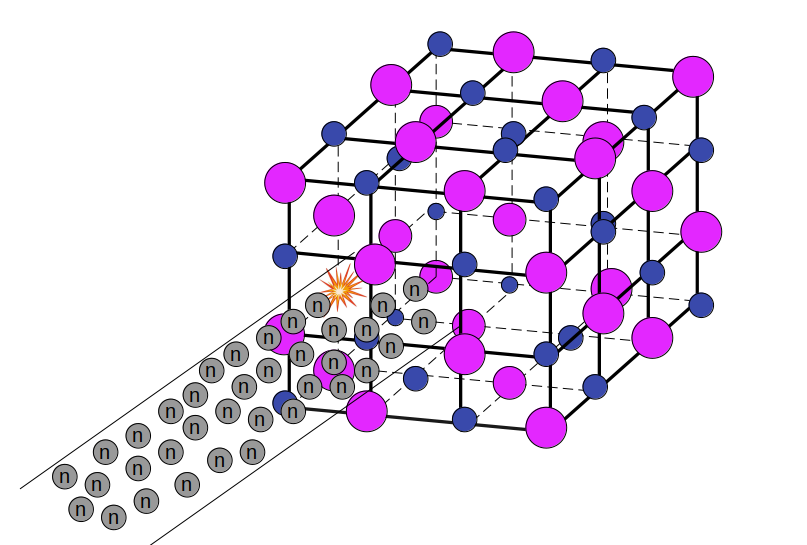
With a group of students and personnel from INFN-Trieste, we have investigated a complex network of nuclear reactions, forming the Jetter's and Post's cycles, that are suitable for releasing energy by fusion reactions happening in solid materials (6-lithium deuteride) irradiated by appropriate neutron beams. We take into account the energy losses due to charged particles travelling a dense medium and despite the loss the net energy gain seems to be worth the efforts. These researches had stopped during the Cold War Era and we believe that there are reasons to resume working on them!
See incredible media reactions at the news!!!
ANSA.it (I)
ANSA.it (II)
LaPiazza.it (I)
LaPiazza.it (II)
Mattino di Padova (printed)
L'eco di Bergamo
Telenuovo TG
La Provincia di Como
La Provincia UnicaTV (Lecco-Sondrio)
Nuclear Physics - Phys. Rev. C 111, 034307 (2025),
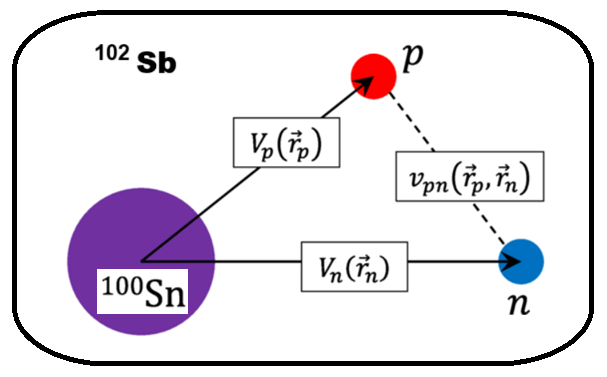
With Tomohiro Oishi (former post-doc here in Padova) and Masaaki Kimura, we have investigated the sensitivity of one-proton emission from the nucleus 102Sb and its connection to proton-neutron interaction: this is a very interesting isotope, as the core of 100Sn is considered doubly-magic and while the core-neutron system (101Sn) is bound the core-proton system (101Sb) is unbound. We suggest that, due to weakening of the p-n interaction, 102Sb might be unbound and possibly that low-lying resonant states can be found, from which the system decays by proton emission.
Nuclear Physics - Chin.Phys.C 48, 094102 (2024) and Phys. Scr. 99 (2024) 015305 ,
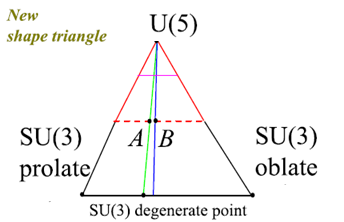
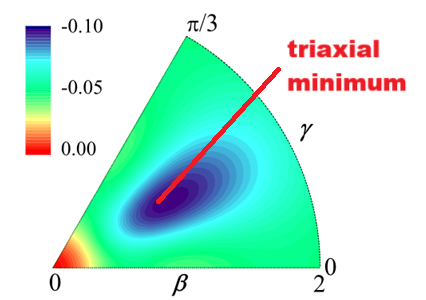
With Chinese colleagues Tao Wang, Bing-cheng He, Chun-xiao Zhou, Dong-kang Li, we have published an interesting study in Chin.Phys.C 48, 094102 (2024) entitled “Emerging gamma-softness in 196Pt in the SU3-IBM” where thephenomenon of emergent gamma-softness is shown to be important for understanding the prolate-oblate asymmetric shape phase transition. The new model can account for several observed features in 196Pt. Figure on the left.
With another group of Chinese colleagues: Wei Teng, Sheng-Nan Wang, Yu Zhang, the paper “Triaxial rotor in the O(6) limit of the interacting boson model”, Phys. Scr. 99 (2024) 015305, explores a new mapping scheme from triaxial roto models to the IBM with symmetry-conserving high-order interactional terms. . It provides a new way to interpret the emergence of triaxiality in the finite-N boson systems. Figure on the right.
Nuclear Physics - Phys. Lett. B 838, 137719 (2023) ,
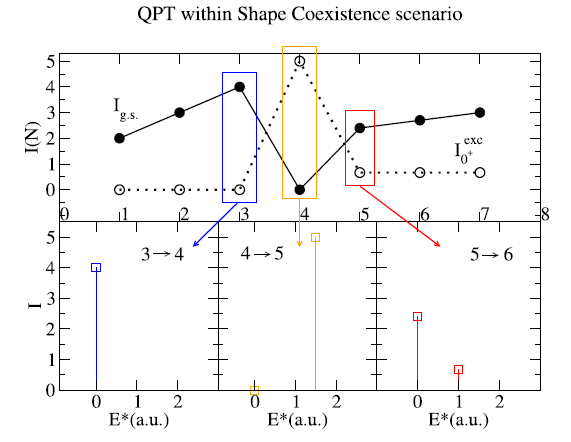
With Jose-Antonio Lay (former post-doc here in Padova), Andrea and other Japanese colleagues, we explored two-particle transfer reactions as a probe for shape coexistence in shape phase transitions. Transfer (t,p) reactions to g.s. and excited 0+ states in even-even Zirconium isotopes show a clear signature for a shape phase transition between 98Zr and 100Zr, which displays coexistence of a deformed ground state with an excited spherical 0+ state. there is in this case a qualitative difference with respect to a normal shape phase transition and two-neutron transfer can discriminate between these two scenarios.
Nuclear Physics - Phys. Lett. B 834, 137413 (2022),
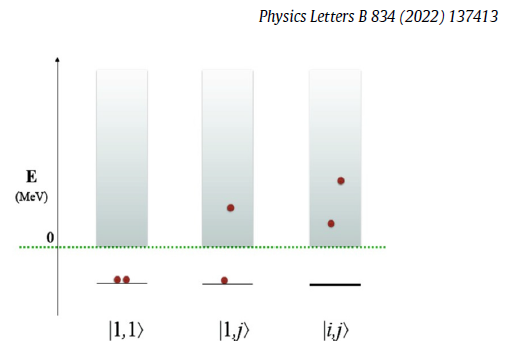
With Gagandeep Singh and Andrea Vitturi, we have explored the role of constructive interference through open reaction channels in the continuum in two-neutron transfer reactions of the type A -> (A+2). We compare the realistic case of an unbound (A+1) system with an artificially bound case for the system 4He -> 5He -> 6He, finding out the differences. We find that the pairing correlations between the transferred nucleons, which are prevalent in the unbound 5He case than in the bound case, enhance the transfer cross-sections considerably, (depending on the bombarding energy). This helps to understand not only the structure of the final body, but also the dynamics of the transfer process.
Nuclear Physics - Commun. Phys., 3, 132 (2020) - a Nature research journal.
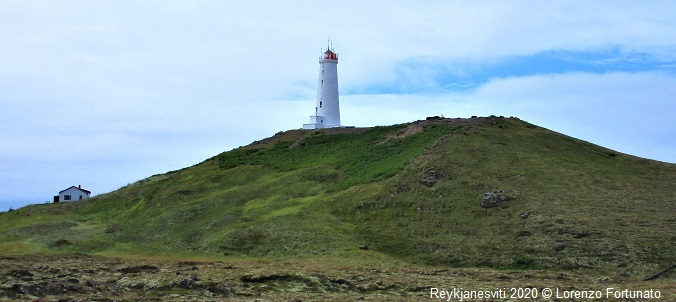
Our previous work on 29F got new energy after new sets of experimental measurements were released, and led to the present open-access Perspective paper on Communication Physics.
The exotic, neutron-rich and weakly-bound isotope 29F stands out as a waymarker on the southern shore of the island of inversion, a portion of the nuclear chart where the effects of nuclear forces lead to a reshuffling of the single particle levels and to a reorganization of the nuclear structure far from stability. This nucleus has become very popular, as new measurements allow to refine theoretical models. We review the latest developments and suggest how to further assess the structure by proposing predictions on electromagnetic transitions that new experiments of Relativistic Coulomb Excitation should soon become able to measure.
Full text at: https://rdcu.be/b50yV
Nuclear Physics - Phys. Rev. C 101 , 024310 (2020).
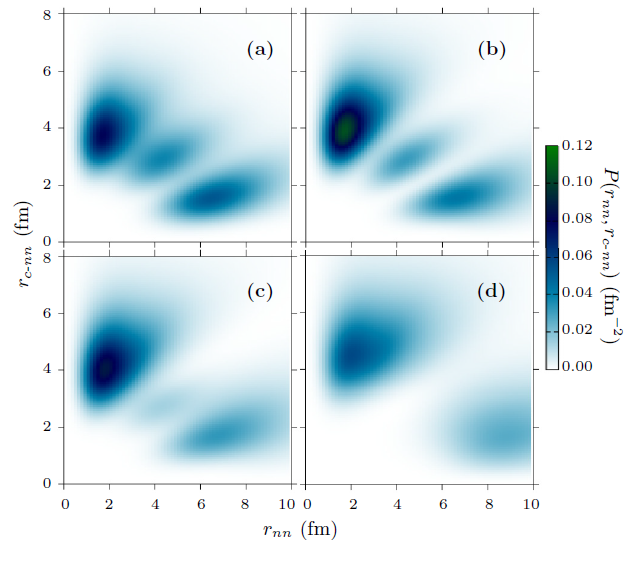
Together with Jagjit Singh (first author), Jesus Casal (who made three-body calculations), Wataru Horiuchi and Andrea Vitturi, we have investigated the configuration mixing and matter radius of the ground-state of the very exotic nucleus 29F using a three-body model. We have found that there is the possibility that 29F has a moderate two-neutron halo structure. We have identified four scenarios for the 27F+n phase shifts and this, together with neutron correlations, leads to the structure of 29F. The picture shows ground state probability densities as a function of distance between core and dineutron (vert.) and distance between the neutrons (horiz.). This nucleus is still poorly known from experiments, therefore our calculations are a first attempt to venture towards the dripline that is probably located at 31F.
Nuclear Physics - Phys. Rev. C 101 , 014315 (2020).
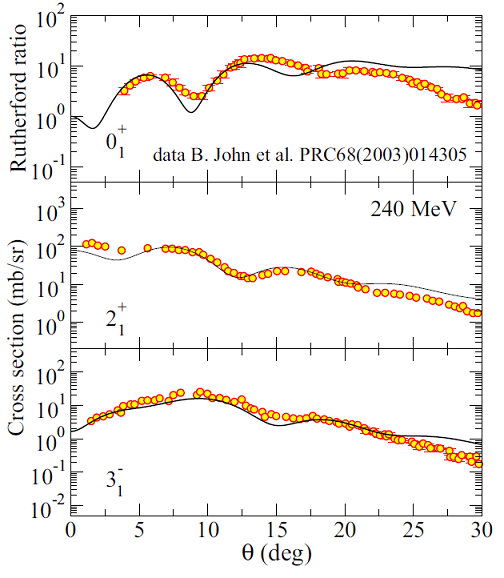
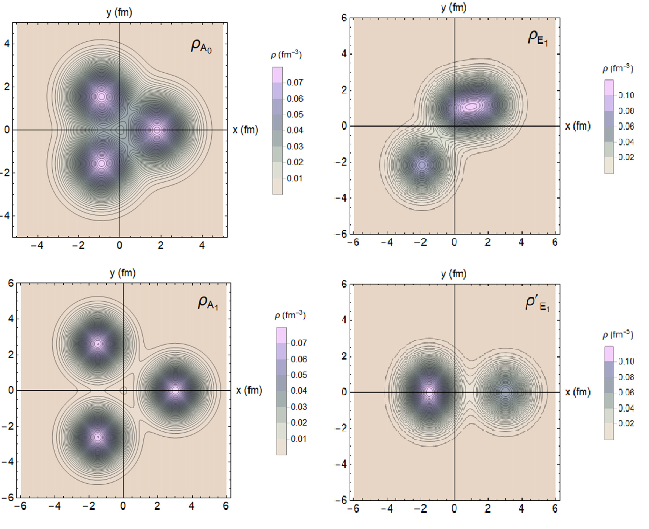
With several collaborators, we have calculated densities (see picture) and transition densities of 12C in the triangular alpha-cluster model, finding interesting results about the Hoyle-band (A-type) and the doubly-degenerated E-type band. After a detailed analysis of the various components of the transition densities, we have calculated form factors and cross-sections for the 12C(alpha,alpha) inelastic scattering reaction, obtaining a good comparison with experimental data (see a few examples in the second picture): this indicates that the cluster model works fairly well also for reactions involving the cluster degree of freedom.
Nuclear Physics - Phys. Rev. C 99 , 031302(R) (2019). Rapid Communication, picked as an Editors'Suggestion.
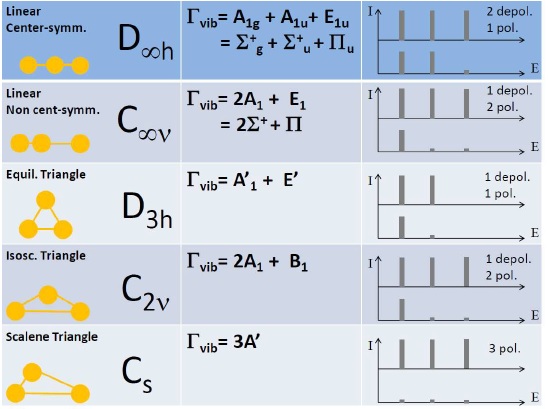
I have suggested that linearly polarized gamma-rays with good energy resolution (as those that will soon be available at ELI-NP) can be effectively used in Raman scattering experiments on 12C, in which the polarization ratio (i.e., the ratio of perpendicular to parallel emitted intensities) is measured, to determine the exact geometrical configuration of the three alpha clusters that are thought to form this nucleus in a sort of nuclear molecule. If this is true, the molecule can have only 5 different possible shapes that correspond to discrete point-group symmetries: linear centrosymmetric, linear non-centrosymmetric, equilateral triangle, isosceles triangle or scalene triangle. The outcome of the proposed experiment, once matched to a list of theoretical patterns that are calculated in this Rapid Communcation, can discriminate between the various shapes and symmetry. This will give a final answer to the question of the configurations of alpha-clusters in Carbon-12.
Nuclear Physics - J.Phys. G: Nucl. Part. Phys. 45 (2018) 105101.

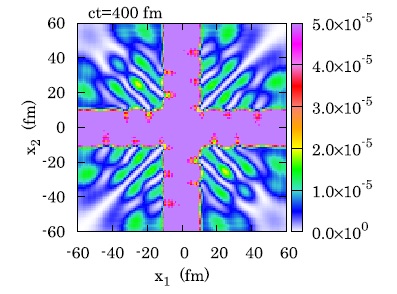
T. Oishi has thoroughly investigated the temporal evolution of a spin-triplet and spin-singlet resonant states in unstable systems in which two correlated fermions are emitted. The tunnelling emission probability from a triplet state depends on the strength of the interaction between the correlated fermions and it is fundamentally different from the emission originating from a spin-singlet state: the difference is due to anti-symmetrization that allows or forbid degenerate pairing configurations. These results are of general importance, not limited to nuclear systems.
Nuclear Physics - Computation 6(3), 48 (2018).
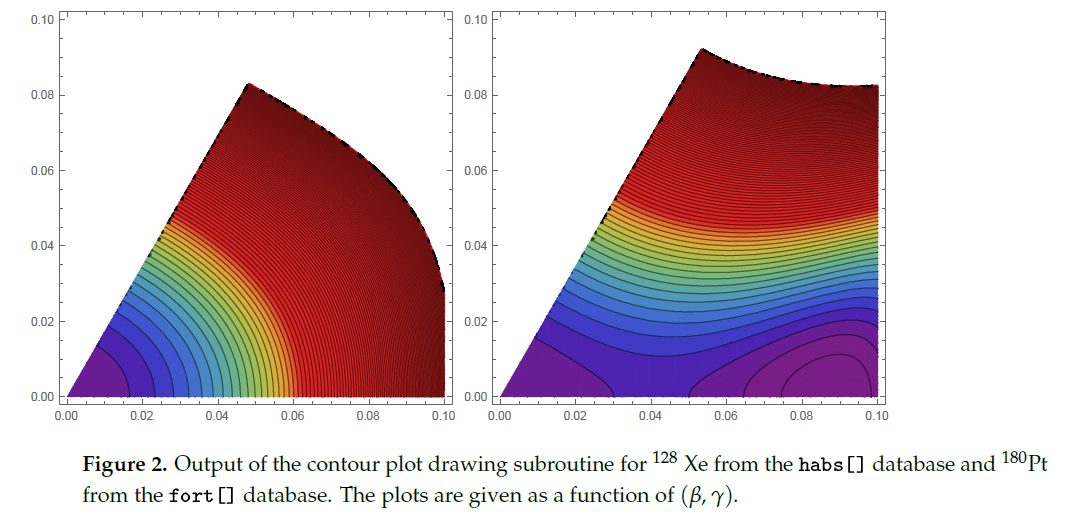
Following the M.Sc. thesis of F. Ferrari-Ruffino, we have written a Mathematica notebook that performs diagonalization of the Geometric Collective Model, i.e. calculates the eigenenergies and eigenstates of the Bohr hamiltonian for quadrupole vibrations and rotations with the Gneuss-Greiner potential, that allows for spherical, prolate, oblate, gamm-unstable and triaxial solutions. The program can also perform serches of "best" potential parameters, given an experimental input (inverse problem) using a random walk algorithm, initally developed in PRC 74 (2006). A couple of databases with coefficients are given as an example and the user can run the code and find new ones.
FOLDER MISSING:
the folder with the N40 matrices used by the notebook is missing in the journal webpage, you can download it HERE and extract it to the working directory!Nuclear Physics - J.Phys. G. 43 (9) , 093003 (2016).

With P.Buganu (IFIN-HH, Romania) we have looked again at the quadrupole degree of freedom, in particular to new solutions of the Bohr hamiltonian and to new approaches (both algebraic and analytic). This paper updates and extends my previous Eur. Phys. A dir. 26 (2005).
The image on the left was selected as Cover Image for the volume 43(9) of the JPG!
Nuclear Physics - J.Phys. G. 43 , 085104 (2016).

Following the M.Sc. thesis of G.Stellin, we have calculated electromagnetic selection rules between vibrational bands in the 3 alpha cluster model of 12C. In this model, that has returned prominantly to the fore thanks to the ACM of Bijker and Iachello, the alpha particles are placed at the vertexes of an equilateral triangle and the point-group symmetry D3h follows. The normal modes of vibrations are classified as A (g.s. and Hoyle bands) and E bands. We have succesfully reproduced old tables of quantum numbers of Wheeler (1937) and we have looked at the character, under transformations of the group, of the electromagnetic operators and e.m. matrix elements between states of the model, finding sets of allowed and forbidden transitions. One discovers for example that E1 and M1 transitions are forbidden in the model.
Molecular Physics - Phys.Rev. A 94, 032508 (2016).
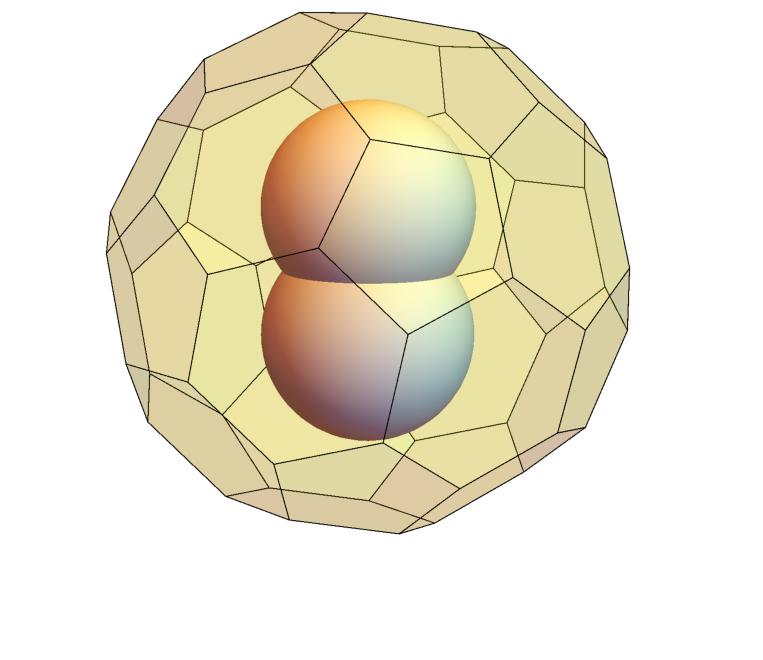
With Curro Perez-Bernal (Huelva, Spain), we have devised an algebraic theory for a diatomic H2 molecule trapped inside a C60 fullerene cage based on the u(4) x u(3) dynamical symmetry. The resulting energy formulas is compact and versatile and the energy spectrum of the endohedrally confined molecule can be fitted succesfully with a small set of parameters, allowing for very good reproduction of known transition lines, for reassignement of quantum numbers of a few states and for predictions for new rotational-vibrational states. The caged system displays quantized translational motion of the whole molecule inside the C60 cage and the algebraic theory naturally entails all the quantum numbers arising from this feature.
Nuclear Physics - Eur. Phys. J. A 52, 209 (2016).
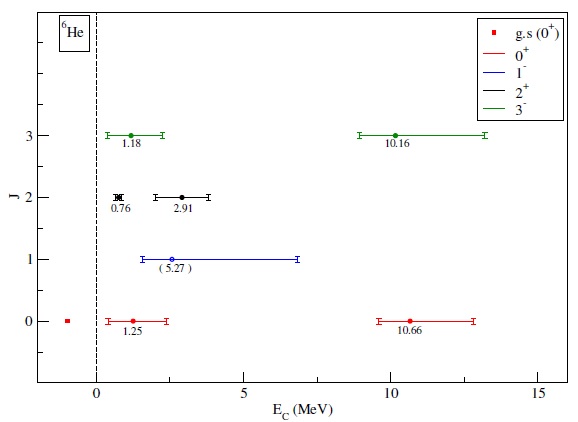
The Ph.D. thesis of Jagjit Singh (Univ. Padova, 2016) was centered around calculating the electromagnetic response of 6He in a core+n+n model in which the two neutrons interact via a contact pairing interaction. This interaction is necessary to bind the system and we set it to the bound g.s.. We used a discretization procedure to treat the two-neutron continuum and we calculated the electric monopole, dipole, quadrupole (see previous works) and octupole response for transitions from the ground state to the continuum. The final predictions for all these transitions J=0,1,2,3 can be seen in the picture as a function of the energy in the continuum, with points indicating the maximum of the strength distribution and lines indicating the FWHM.
Nuclear AstroPhysics - Phys. Lett. B 755, 275-278 (2016).
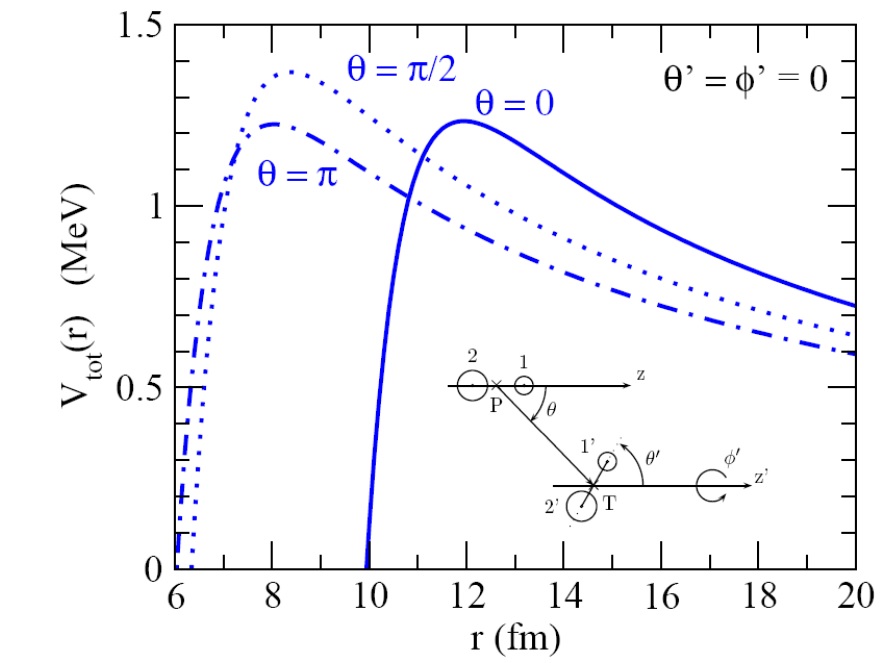
Following the initial idea of Carlo Spitaleri (Catania, Italy) and Carlos A.Bertulani (Texas A&M, USA), we have joined forces with them and suggested that the origin of the anomalously high electron screening potential, that is invoked to explain the reaction rates <σv> of several light nuclei in stellar plasma, is indeed due to a nuclear physics effect, rather than to an atomic effect. In fact several light nuclei exhibit clusterization in their ground states and the geometrical arrangement of nucleons in the clusters modifies the height and width of the Coulomb barrier (see picture for an example of 6Li impinging on 6Li) and consequently the Gamow penetrability and the fusion rates. Lower average barriers mean higher fusion rates and thus the discrepancies seen between the experimental and adiabatic electron screening potentials for reactions involving these nuclei are explained.
While the electron screening potential retains its chief importance as an effect of atomic physics (thus present in all reactions), the so-called electron screening puzzle seen in light nuclei requires an explanation in terms of nuclear structure models.
Press release at Phys.org
Nuclear Physics - Nature Commun. 6, 6743 (2015).
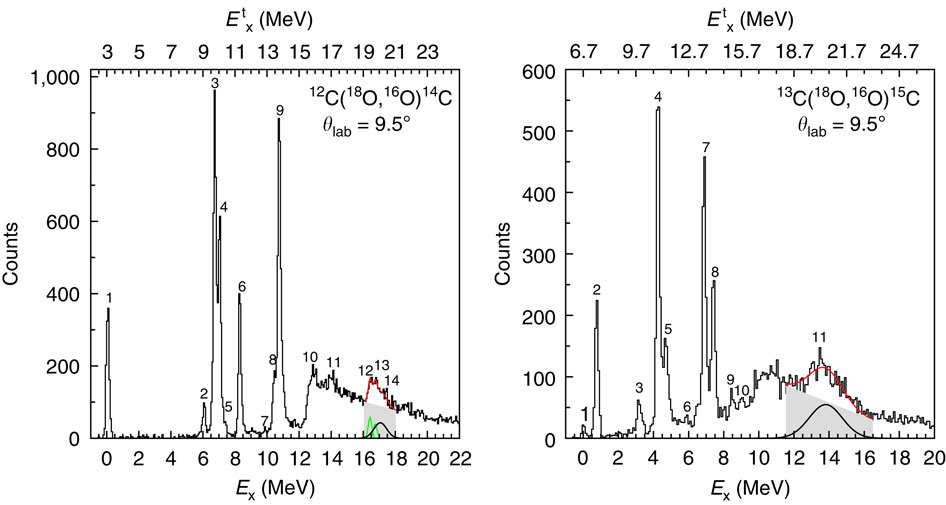
The experimental effort of an international team of nuclear physicists at the Laboratori Nazionali de Sud (Catania, Italy) coordinated by Francesco Cappuzzello, has lead to the discovery of the Giant Pairing Vibration (GPV) in carbon isotopes, measured at the MAGNEX spectrometer. The GPV states have been populated through two-neutron transfer reactions 12C(18O,16O)14C and 13C(18O,16O)15C. The extraction of strengths and angular distributions leaves no doubt about the presence of 0+ states in the energy range (about 15 MeV) where the GPV are expected to occur. This measurement marks the first set of experimental proofs that the GPV exists, giving a confirmation that the particle-hole symmetry in nuclei is a well-taken assumption.
Nuclear Physics - Phys.Rev. C 90 (2014), 064301.
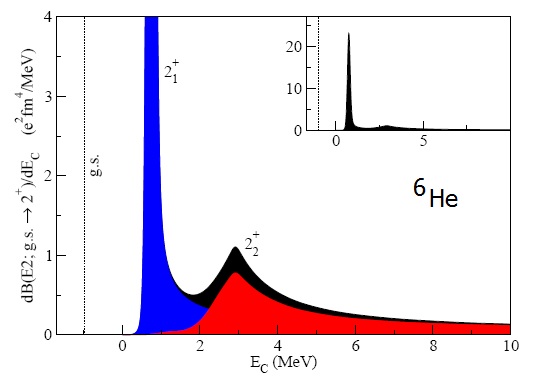
With J.Singh, R.Chatterjee and A.Vitturi, we have built a simple structure model for 6He ground and continuum states starting from the continuum single-particle p states of 5He. The p3/2 and p1/2 resonances of 5He are reproduced and the states in 6He are calculated with a contact delta interaction. We have calculated the 0+ -> 2+ quadrupole response (see picture, black color) finding two resonances, the narrow low-lying 2+ (in blue) and a broader 2+ at 2.9 MeV above threshold with a width of about 1.8 MeV (in red). This calculation is discussed and compared with recent experimental measurements performed at GANIL.
Nuclear Physics - Phys.Rev. C 89 (2014), 034618
.jpg)
.jpg)
With Jose'-Antonio Lay and Andrea Vitturi, we looked at several two-neutron transfer reactions of the type (t,p), (14C,12C) and (18O,16O) on selected targets to investigate the properties of systems such as 112Sn, 32Mg and 68Ni. In the pictures you see the ratios of cross sections obtained for the excited and ground 0+ states in the reaction 30Mg(18O,16O)32Mg at E = 26 MeV, as a function of the mixing probability parameter (this is telling the composition of a certain configuration in terms of 0p-0h and 2p-2h components). The different curves correspond to different choices of the structure of the addition and removal pairs and highlight that this ratio can be used to pinpoint the most relevant components of the wavefunction. Similarly, the second picture displays the reaction 66Ni(14C,12C)68Ni at E = 32.4MeV and highlights the predicted ratio, based on recent measurements of the (t,p) reaction.
Nuclear Physics - Phys.Rev. C 84 (2011) 014326
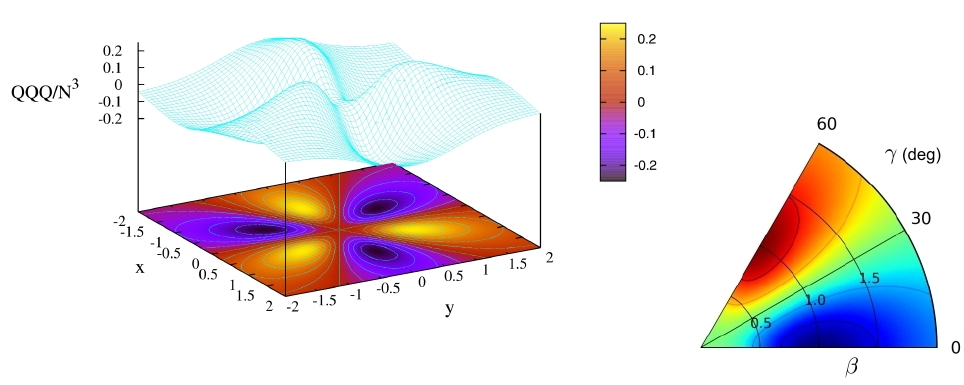
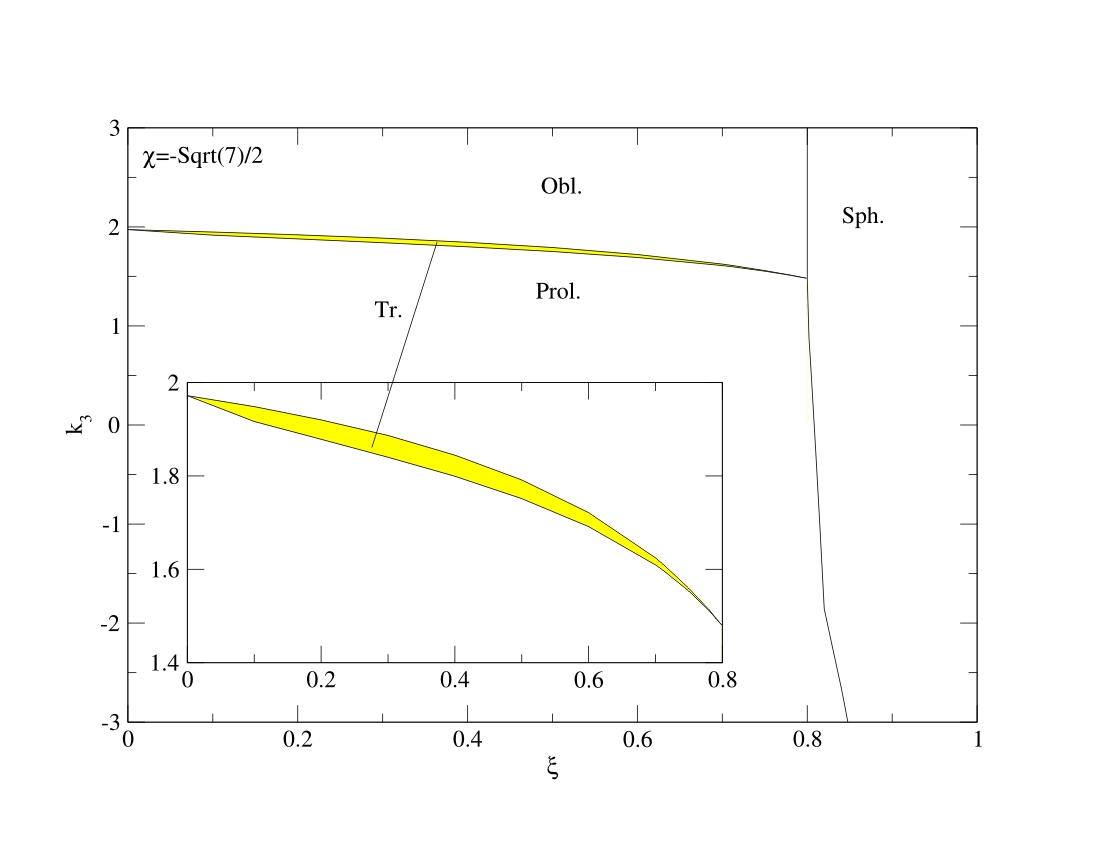
I have calculated the potential energy surface associated to the (QxQxQ) term in the coherent state formalism for IBM-1, that is plotted in the middle and right part of the figure.
Together with collaborators of Sevilla and Huelva we studied the phase diagram of a modified Q.Q hamiltonian, including the cubic term that displays a tiny triaxial region close to chi=-sqrt(7)/2. The small yellow area in the left part of the figure indicates the triaxial phase on a certain face of the phase diagram and extends all over the deformed region, separating prolate from oblate shapes. It is surprising that, as soon as one moves away from the maximal values of chi, the triaxial phase narrows very quickly and we could not numerically nor analitically determine if it continues all the way up to the O(6) point or if it stops at some value of chi intermediate between -sqrt(7)/2 and 0.
* Cocoyoc 2012 - Beauty in Physics - pdf version of my presentation
Molecular Physics - Physics Letters A376 (2012) 236244
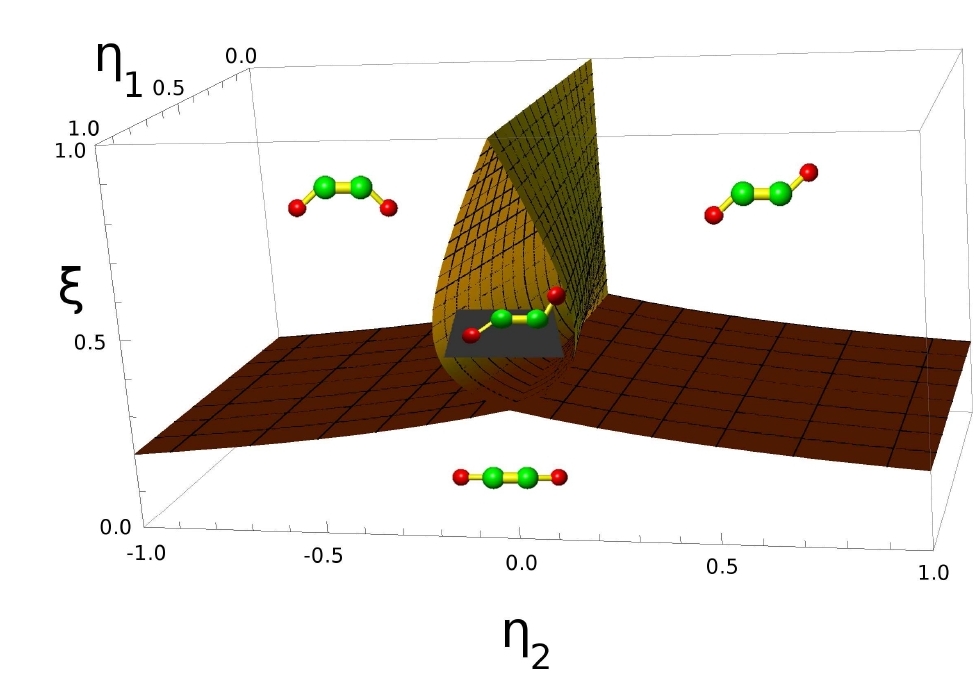
In collaboration with Curro Perez-Bernal, we have studied the phase diagram of ABBA molucules within a U(3)xU(3) algebraic approach.
The phase diagram has three control parameters and displays four phases: linear, cis-bent, trans-bent and non-planar, separated by phase transition surfaces as in figure. The spherical region (corresponding to linear molecules) is at the bottom, and the deformed region is divided in two symmetrical halves corresponding to cis- or trans- configurations (with planar molecules, with different position of the external atoms), separated by non planar configurations (3 atoms in one plane and the fourth outside).
Mathematical Physics - J.Phys.A.Math. Theor. 44 (2011), 145206

In collaboration with Willem De Graaf, we have written several files for GAP4 that implement various Lie algebras of common use in physics. We used them to study the Weighted Dynkin Diagram of each subalgebra chain and in particular we addressed the complete tensor analysis of the su(4) algebra associated with the vibron model with respect to all possible A1 subalgebra contained in it.